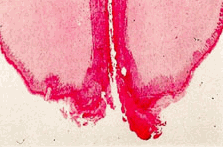



Teat End Condition Matters
This spring I have noticed a lot rougher teat ends than usual, writes Jeffrey Reneau, Professor of Dairy Management, University of Minnesota, Dairy Extension.
This observation has probably been caused in part by our recent long winter. Generally, teat condition is worse in harsh winter weather and chapping of teats tends to make teat-end condition worse as well. A teat end in good condition is important for resisting mastitis. The teat canal is the cow’s last line of defense and the primary physical barrier preventing invasion of mastitis pathogens into the udder.
Repeated milking of cows results in callous ring formation around the teat orifice just like we get callused hands from manual work. This callus formation, called hyperkaratosis, was first described by Dr. Ralph Farnsworth, University of Minnesota veterinarian, and his graduate student Dr. Bob Sieber more than 25 years ago.
Dr. Farnsworth developed a teat-end scoring system that has been modified and is still in use today (see Teat End Condition Score Card that accompanies this article). Excessive teat end callus provides a rough surface for bacteria to be trapped or colonize as can be seen in the microscopic picture of a teat end (Figure 1). In addition, the excess callus formation can also change teat canal integrity and teat tissue pliability thus favoring penetration of bacteria into the udder. Studies in the Netherlands indicate that cows with rough or very rough teat ends are more prone to having high SCC or clinical mastitis.
 |
|
Figure 1. Microscopic view of a very rough teat end (Score 4).
|
If you are wondering if teat-end condition is a problem on your farm, the first step is to use the Teat End Condition Score Card to score your herd. Each cow’s score should be based on the worst teat score of the four teats. Be sure that you score enough cows for your herd assessment to be valid. For herds less than 100 cows, it may be practical to score the entire herd. For large herds, score a minimum of 80 randomly selected cows or 20% of the herd, whichever is the highest number. Although a small amount of teat-end callus (hyperkaratosis) is inevitable and of no concern, if large numbers of cows in your herd (> 20%) have teat-end scores greater than a Score 2, you should try to determine the cause and then develop an action plan.
Cow factors
- Teat-end shape and length (long pointed teats prone to more hyperkaratosis).
- Teat position (malpositioned teats may be prone to more hyperkaratosis).
- Milk production (high production, higher milk flow, longer machine-on time may contribute to more hyperkaratosis).
- Stage of lactation (later lactation, more hyperkaratosis formation).
- Milking speed (slow milking cows, more machine-on time, more hyperkaratosis).
- Parity (older cows, more exposure to milking, more hyperkaratosis).
Machine factors
- Milking and pulsation vacuum (higher vacuum, faster milk flow).
- Machine-on time (longer machine-on time, more hyperkaratosis).
- Liner type (liner movement).
Management factors
- Milking frequency (2X to 3X increases machine-on time 40%)
- Adequate milk let-down stimulus (cow prep procedure) and prep-lag time (optimal 1-2 minutes)
Generally, longer machine-on time is the main contributor of excessive teat-end hyperkaratosis. Although high milk production is desirable and will require the milking machine to be on the cow longer, organize your milking routine to minimize milking machine-on time. First, provide at least 10 to 20 seconds of teat cleaning and fore-stripping to achieve maximum milk let-down stimulation.
Then allow 1 to 2 minutes of prep-lag time before milking machine attachment to assure optimal milk flow rates. Also be sure that your milking equipment is functioning properly and is routinely maintained. Too many farms do not have milking equipment checked before a problem occurs. In addition, during cold winter weather it may be wise to use a cold weather teat dip designed to reduce teat skin drying, which can cause the thick callus to crack, further complicating the problem.
|
Teat End Condition Score Card
|
||
| Score | Description | Illustration |
|---|---|---|
| Score 1 (N) | No Ring. The teat-end is smooth with a small, even orifice. This is a typical status for many teats soon after the start of lactation. |  |
| Score 2 (S) | Smooth or Slightly Rough Ring. A raised ring encircles the teat orifice. The surface of the ring is smooth or it may feel slightly rough but no fragments of old keratin are evident. |  |
| Score 3 (R) | Rough Ring. A raised, roughened ring with isolated fragments of old keratin extending a short distance from the teat orifice. |  |
| Score 4 (VR) | Very Rough Ring. A raised ring with rough fragments of old keratin extending out from the teat orifice. The rim of the ring is rough and may be cracked, often giving the test-end a “flowered” appearance. |  |
| Score 5 | Open Lesions or Scabs. | Not pictured. |
June 2008



